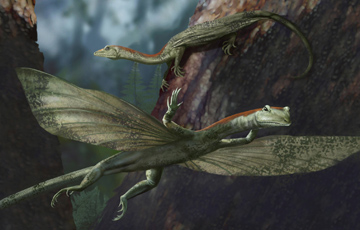Ancient gliding reptile discovered
Ancient gliding reptile discovered
Society of Vertebrate Paleontology
June 12, 2007
A remarkable new long-necked, gliding reptile discovered in 220 million-year old sediments of eastern north America is described in the latest issue of the Journal of Vertebrate Paleontology (Vol. 27, No. 2), scientists report. Mecistotrachelos apeoros (meaning “soaring, long-necked”) is based on two fossils excavated at the Solite Quarry that straddles the Virginia-North Carolina state line.
Nick Fraser of the Virginia Museum of Natural History, who discovered the fossils, said said “one of the really neat things about the new glider is the feet. They are preserved in a hooked posture which is unusual and strongly suggests a grasping habit, further emphasizing a life style in the trees.” It probably fed on insects, scuttling up tree trunks and foraging on the way, before gliding onto neighboring trees.

Artwork by Karen Car. |
Fraser said that while two other reptiles with similar gliding membranes are known from the Triassic Period, they have much shorter necks and therefore conform more to the modern gliding lizard, Draco.
The relationships of Mecistotrachelos are unclear, but Fraser considers that it is probably related to the protorosaurs. Protorosaurs are a group of extinct reptiles characterized by a long-necked, including the bizarre Tanystropheus which had a neck longer than the length of the body and tail combined.
Because of the nature of the sediments, it was not possible to prepare the fossils by standard mechanical methods and the descriptions are based entirely on CT scans. This technique has only been rarely used to describe new species. Tim Ryan of the Center for Quantitative Imaging at Pennsylvania State University led the work on the CT scanning.
“This is a really cool little reptile which was very difficult to see until we looked at the CT scans”, commented Ryan. The other authors are Alton Dooley, also of the Virginia Museum of Natural History, and Paul Olsen of the Lamont Doherty Earth Observatory, Columbia University who originally discovered the site over 30 years ago.
The ongoing excavations at the quarry by the Virginia Museum of Natural History have been supported by the National Geographic Society and the US National Science Foundation.
Founded in 1940 by thirty-four paleontologists, the Society of Vertebrate Paleontology’s more than 2,000 members represent professionals, students, artists, preparators, and others interested in vertebrate paleontology. It is organized exclusively for educational and scientific purposes, with the object of advancing the science of vertebrate paleontology. The Journal of Vertebrate Paleontology is the Society’s flagship publication and is the leading journal of professional vertebrate paleontology.